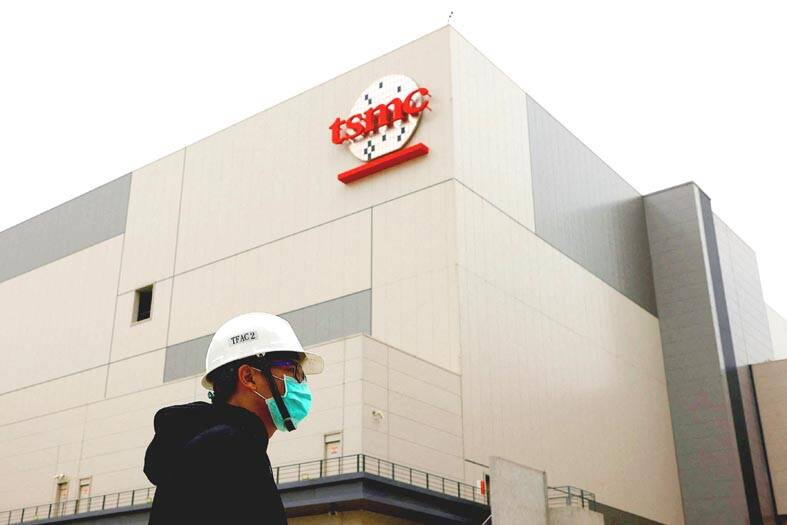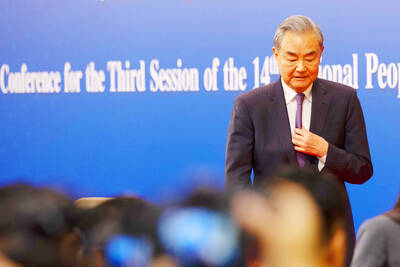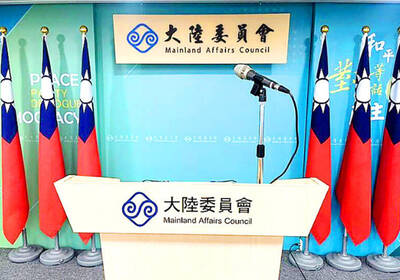South Korea’s SK Hynix Inc, the world’s second-largest memorychip maker, yesterday said that it would collaborate with Taiwan Semiconductor Manufacturing Co (TSMC, 台積電) to make the next-generation high-bandwidth memory (HBM) chips used in artificial intelligence (AI) technology.
SK Hynix dominates the market for HBM chips — crucial components to power AI — and is a top supplier to US-based chip titan Nvidia Corp. TSMC also supplies Nvidia.
The South Korean company “recently signed a memorandum of understanding with TSMC for collaboration to produce next-generation HBM,” SK Hynix said in a statement.

Photo: Ann Wang, Reuters
SK Hynix “plans to proceed with the development of HBM4, or the sixth generation of the HBM family, slated to be mass produced from 2026, through this initiative,” the statement added.
“We expect a strong partnership with TSMC to help accelerate our efforts for open collaboration with our customers and develop the industry’s best-performing HBM4,” SK Hynix president Justin Kim said. “With this cooperation in place, we will strengthen our market leadership as the total AI memory provider further by beefing up competitiveness in the space of the custom memory platform.”
To develop HBM4, TSMC’s “advanced logic process” would be adopted to produce “customized HBM that meets a wide range of customer demand for performance and power efficiency,” SK Hynix said.
The two companies would also collaborate to optimize the integration of SK Hynix’s HBM and TSMC’s chip-on-wafer-on-substrate packaging process, the South Korean company said.
“TSMC and SK Hynix have already established a strong partnership over the years. We’ve worked together in integrating the most advanced logic and state-of-the art HBM in providing the world’s leading AI solutions,” TSMC deputy cochief operating officer Kevin Zhang (張曉強) said.
SK Hynix last month said that it had begun mass production of the HBM3E, the latest HBM iteration.

‘DANGEROUS GAME’: Legislative Yuan budget cuts have already become a point of discussion for Democrats and Republicans in Washington, Elbridge Colby said Taiwan’s fall to China “would be a disaster for American interests” and Taipei must raise defense spending to deter Beijing, US President Donald Trump’s pick to lead Pentagon policy, Elbridge Colby, said on Tuesday during his US Senate confirmation hearing. The nominee for US undersecretary of defense for policy told the Armed Services Committee that Washington needs to motivate Taiwan to avoid a conflict with China and that he is “profoundly disturbed” about its perceived reluctance to raise defense spending closer to 10 percent of GDP. Colby, a China hawk who also served in the Pentagon in Trump’s first team,

SEPARATE: The MAC rebutted Beijing’s claim that Taiwan is China’s province, asserting that UN Resolution 2758 neither mentions Taiwan nor grants the PRC authority over it The “status quo” of democratic Taiwan and autocratic China not belonging to each other has long been recognized by the international community, the Mainland Affairs Council (MAC) said yesterday in its rebuttal of Beijing’s claim that Taiwan can only be represented in the UN as “Taiwan, Province of China.” Chinese Minister of Foreign Affairs Wang Yi (王毅) yesterday at a news conference of the third session at the 14th National People’s Congress said that Taiwan can only be referred to as “Taiwan, Province of China” at the UN. Taiwan is an inseparable part of Chinese territory, which is not only history but

CROSSED A LINE: While entertainers working in China have made pro-China statements before, this time it seriously affected the nation’s security and interests, a source said The Mainland Affairs Council (MAC) late on Saturday night condemned the comments of Taiwanese entertainers who reposted Chinese statements denigrating Taiwan’s sovereignty. The nation’s cross-strait affairs authority issued the statement after several Taiwanese entertainers, including Patty Hou (侯佩岑), Ouyang Nana (歐陽娜娜) and Michelle Chen (陳妍希), on Friday and Saturday shared on their respective Sina Weibo (微博) accounts a post by state broadcaster China Central Television. The post showed an image of a map of Taiwan along with the five stars of the Chinese flag, and the message: “Taiwan is never a country. It never was and never will be.” The post followed remarks

INVESTMENT WATCH: The US activity would not affect the firm’s investment in Taiwan, where 11 production lines would likely be completed this year, C.C. Wei said Investments by Taiwan Semiconductor Manufacturing Co (TSMC, 台積電) in the US should not be a cause for concern, but rather seen as the moment that the company and Taiwan stepped into the global spotlight, President William Lai (賴清德) told a news conference at the Presidential Office in Taipei yesterday alongside TSMC chairman and chief executive officer C.C. Wei (魏哲家). Wei and US President Donald Trump in Washington on Monday announced plans to invest US$100 billion in the US to build three advanced foundries, two packaging plants, and a research and development center, after Trump threatened to slap tariffs on chips made